|
Two Berkeley Lab Scientists Win National
Medal of Science
Two Berkeley Lab Scientists Win
|
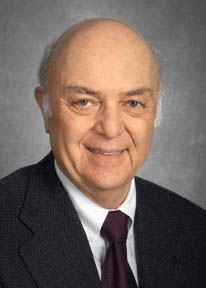 Marvin Cohen |
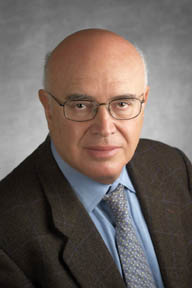 Gabor Samorjai |
Cohen and Somorjai may be two of a kind, but each has broken the mold in his own chosen field. Cohen, who holds joint appointments with MSD and the UC Berkeley Physics Department, is a theorist recognized worldwide as a master at creating atom-by-atom models that explain and predict the properties of solid materials. Most recently, he has been at the forefront of the nano-revolution, having successfully predicted a nanosized semiconductor tube made of boron nitride that was subsequently synthesized.
Somorjai, who holds a joint appointment with MSD and the UC Berkeley Chemistry Department, is an international authority on catalysis and regarded by his peers as the father of modern surface chemistry. He, too, has been at the nanoscience forefront, having recently used a nanoparticle array of platinum crystals on a silicon oxide surface to create the prototype for a high-tech catalyst.
Both men were notified they had won the award via a phone call from John Marburger, science adviser to President Bush.
Said Cohen, in reaction, “I have thought about physics every day in some capacity for the past 50 years. I was interested in physics as a child even before I knew it was physics, and so this is a most gratifying recognition.”
Said Somorjai, “No award could mean more to me than this. It has always been my hope that I was giving back something in return for the opportunities this country has given me. I have been so lucky and I appreciate my good fortune.”
Berkeley Lab Director Charles Shank expressed his appreciation for having two Lab scientists recognized.
“The prestigious honors received by Marvin and Gabor bring distinction to Berkeley Lab and are testimony to our impressive heritage in the fields of materials theory and surface science,” Shank said. “Both in their fifth decade of service to our Laboratory and to the nation, they are now integral parts of our investigations at the frontiers of nanotechnology, again bringing their celebrated expertise to bear on the most pressing scientific challenges of our time.”
The addition of Cohen and Somorjai brings the number of Berkeley Lab winners of the National Medal of Science to an even dozen, starting with 1963, when Luis Alvarez won in the physical sciences category. The medal was established by Congress in 1959 as a presidential award to be given to individuals “deserving of special recognition by reason of their outstanding contributions to knowledge in the physical, biological, mathematical, or engineering sciences.” In 1980, Congress expanded this recognition to include the social and behavioral sciences.
There were 15 recipients of this year’s National Medal of Science. Cohen won in the category of physical science, Somorjai in chemistry. They will receive their medals from President Bush at a White House ceremony later this summer. Cohen will be attending the White House awards ceremony with his wife, Suzy. Somorjai will attend with his wife, Judith. Both couples will also be joined by other family members.
By Monica Friedlander
Last week, the last exterior pieces of Building 29 came down like a house of cards, crushed by the jaws of an excavator with a 30-foot reach. And along with the structure, down went a piece of Laboratory history. It is little wonder that both nostalgia and fascination greeted the long awaited removal of the unsafe and long-vacated building. The demolition project, which began on April 29 and included aerial lifts of the exterior siding, will now continue with removal of the foundations and regrading of the site to previous natural contours.
A victim of termites, wood rot, and outdated building codes, the low-rise wood-frame building was constructed during the 1940s and was part of a complex of structures known as the Central Research Area, dating back to the early days of the Laboratory. This included some original Laboratory sites, such as Buildings 25, 16, 14, and 7.
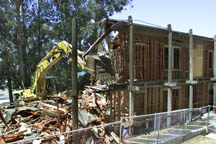 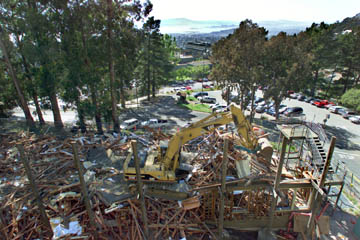 |
The building was vacated and readied for demolition after determination that it was not structurally sound and prone to collapse. Moreover, Building 29, like other single-story trailers and low-rise buildings in the area, make inefficient use of prime space on the hill. The project will eventually replace the dry lab space of World War II-era structures with modern office space.
Many of the materials from Building 29 were salvaged for recycling, including the exterior wood siding, windows, doors, hardware, electrical panels, pipe, exterior metal stairs, and concrete.
After the last debris and the concrete foundation are removed, the soil will be graded to its natural slope and seeded for natural vegetation.
The site is currently fenced to provide a work zone and safety barrier. Alternate pedestrian paths have been created and signs noting hazards associated with the work are posted in the area.
For more information on construction activities, contact the LBNL’s construction superintendent Sam Birky at X7932.
By Ron Kolb
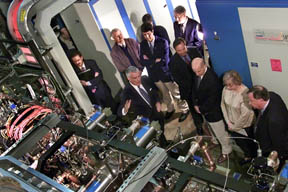 Rod Keller, senior team leader on the project, leads a tour of the front-end systems — Berkeley Lab’s part of the SNS project. Participating are (from the right) Lab Director Charles Shank and Deputy Director for Operations Sally Benson. |
There was the familiar Berkeley spring chill in the air when the 100 bodies huddled outside in the parking lot of Building 71 on May 2. But they were warmed by the glow of the words spoken by Thom Mason, executive director of the Spallation Neutron Source (SNS).
“You have given a tremendous gift to the scientific community,” he told the assembled team shivering and seated around six-foot tables. “We promise to take care of your ‘baby.’ We’ll put it in a nice building, and we will treat it with the respect it deserves.”
The “baby” is the front-end systems for what will be the world’s premier facility for neutron research when it’s completed in 2006. Berkeley Lab took three and a half years and $20.1 million to construct the high-powered ion source, and it happened on time and on budget.
“This is a significant milestone in the six-lab partnership,” Berkeley Lab Director Charles Shank told the design and construction team during a special ceremony honoring the completion and commissioning of the front end systems. “This is a unique operational structure, one whose success may be critical for support of future scientific projects by the Department of Energy.”
The SNS, located at Oak Ridge National Laboratory in Tennessee, represents the largest single project in the Office of Science’s portfolio. The $1.4 billion machine will provide the world’s most intense pulsed beams of neutrons, the electrically neutral subatomic particles that can serve as deep-penetrating, non-destructive probes of solid materials. The SNS will deliver an average of 1.4 million watts of neutron beam power onto a target — nearly 10 times the capacity of today’s most powerful pulsed neutron sources.
At the ceremony, Mason praised Berkeley Lab’s role in the SNS even prior to the completion of the components. He noted the Lab’s participation in early discussions about a megawatt-class spallation device, playing what he called an “honest broker” role to move the idea along.
“Also, Oak Ridge was never an accelerator laboratory,” he said. “Berkeley loaned Jose Alonso to us and helped steer the project through its early days. Now we are an accelerator lab, about to build a really significant device.”
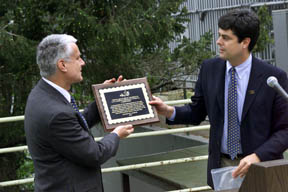 SNS Executive Director Thom Mason (right) presents a plaque to Rod Keller, senior team leader on the front-end systems, in recognition of Berkeley Lab’s successful completion of its part of the project. |
The facility’s front-end systems will generate a beam of negative hydrogen ions and prepare it for delivery into a linear accelerator. From there, the negative ions will be energized to about one billion electron volts in a one-millisecond-long pulsed beam and injected into an accumulator ring. Upon entering the ring, the negative ion beam will be converted into a proton beam and compressed into one microsecond pulse-lengths. It will then be extracted from the ring and smashed into a mercury target to produce neutron beams that can be moderated and guided into designated experimental stations.
Following commissioning tests this month, the whole assembly will be taken apart and packed in crates, hauled to a mammoth building site on a ridgetop in East Tennessee, and reassembled as the first piece of the huge puzzle that will be the SNS.
After Shank, Mason and Berkeley’s senior team leader, Rod Keller, recognized the contributors and toasted the accomplishment, the entire team adjourned to the adjacent hillside for a group photo, then enjoyed a congratulatory barbecue as the gray skies kept things chilly.
But all was bright in Oak Ridge, Tennessee, as construction crews awaited the arrival of the first tangible evidence that, indeed, this broad Office of Science collaboration just might work after all.
SNS Executive Director Thom Mason (right) presents a plaque to Rod Keller, senior team leader on the front-end systems, in recognition of Berkeley Lab’s successful completion of its part of the project.
A new report from the General Accounting Office, the investigative arm of Congress, shows a dramatic decline in the number of Cooperative Research Agreements (CRADAs) between the DOE national laboratories and private industry. Democratic Senator Jeff Bingaman of New Mexico, chair of the Committee on Energy and Natural Resources, at whose request the report was prepared, said he will use the GAO findings to fight for more CRADA funding during the Senate-House conference on a compromise energy bill.
“CRADAs are good not only for the labs, but also for the communities in which the labs are located,” Bingaman said. “They create very good, high-paying jobs.”
The report, entitled, “Technology Transfer: Several Factors Have Led to a Decline in Partnerships at DOE’s Laboratories,” examined the CRADA situation at 12 national laboratories, including Berkeley Lab. CRADAs were established in 1989 to facilitate the transfer of technology from the federal labs to U.S. businesses. Since their high of 1,100 agreements in 1996, the number of CRADAs at these labs has declined to 606 in FY 2001. During that same period at Berkeley Lab, they dropped from 12 to 7 and total active CRADAs dropped from 55 to 30. The GAO report attributed the decline to a reduction in Congressional funding dedicated to CRADAs. As a result, most of these labs provided technical assistance only to companies willing to pay for it, according to the report.
The report did note an increase in other types of agreements, but in none of them do laboratory scientists and engineers have the opportunity to collaborate closely with private industry researchers. Laboratory managers surveyed by the GAO said that they could “effectively use $10 million annually in dedicated funding for CRADAs to develop commercial applications for products.”
A copy of GAO-02-465 is available at http://www.gao.gov/.
Under Secretary of Energy Robert Card has announced DOE plans for a long-term repository science program at Yucca Mountain to conduct research on issues not directly linked to a license application for the site as a nuclear waste repository. This new program would encompass a broad range of topics, including the potential for reducing the toxicity of nuclear waste through processing.
“DOE has been focused on compliance rather than a holistic, systems understanding of the repository,” Card said, speaking before the Nuclear Regulatory Commission last week. “The department’s concentration on a siting decision has resulted in a lot of narrow thinking.”
Saying that DOE wants to “broaden” the scope of what is being studied to the tune of tens of millions of dollars annually, Card added, “I’m willing to spend money to invest in science for its own sake. I don’t think who’s willing to pay should be the driving issue.”
Berkeley Lab Currents recently won second place in the National Association of Government Communicators' 2001 Blue Pencil Awards.
Currents won in the newspaper category. The award was presented to editor Monica Friedlander and science writers Lynn Yarris and Paul Preuss. Tied with Currents for second place was the Smithsonian Institution's The Torch. Inside TVA won first place.
The NAGC is a national nonprofit professional network of federal, state and local government employees. It is the only organization for, by and about government communicators and communications. The organization's Awards of Excellence recognize government agencies or individuals for significant achievement.
The awards are presented during NAGC's annual Communications School, held this year in Washington, D.C.
Among those evacuating their buildings during yesterday’s earthquake exercise, along with the rest of the staff, were Lab Director Charles Shank, Bill McCurdy, head of the Computer Sciences Directorate, and Deputy Director Pier Oddone. Others seemed to have even more fun escaping a would-be disaster. Photos by Valerie Quigley
On April 23, the University of California dedicated its new Washington Center in the heart of the nation’s capital, bringing under one roof more than 250 students, faculty and staff working in Washington and representing all of UC’s 10 campuses.
“The Washington Center serves as a constant reminder of the partnership the University of California has forged with the federal government in educating our next generation of leaders and in expanding the frontiers of knowledge,” said UC President Richard C. Atkinson.
Students from UC undergraduate campuses participate in internships and academic programs at the center while also living in the facility’s onsite residence. The center has seminar rooms with state of the art technology, including a computer lab and videoconferencing capability.
In addition to serving students and faculty, the center is also home to UC’s Office of Federal Governmental Relations and the Institute on Global Conflict and Cooperation.
The 11-story, 176,264-square-foot center is located at 1608 Rhode Island, NW, on Scott’s Circle; it opened in the fall of 2001. The Washington Business Journal nominated the Center as a finalist for best architecture.
California Governor Gray Davis has signed legislation that will provide $308 million in bonds to help build four University of California Institutes for Science and Innovation. State funds must be matched on a two-to-one basis by non-state dollars, creating a three-way partnership between the university, the state, and private industry.
The institutes are: the California Institute for Bioengineering, Bio-technology and Quantitative Biomedical Research (UC San Francisco, UC Berkeley, UC Santa Cruz); the California Nanosystems Institute (UCLA, UC Santa Barbara); the California Institute for Telecommunications and Information Technology (UC San Diego, UC Irvine); and the Center for Information Technology Research in the Interests of Society (UC Berkeley, UC Davis, UC Merced and UC Santa Cruz). — Monica Friedlander
Published twice a month by the Communications Department for the employees and retirees of Ernest Orlando Lawrence Berkeley National Laboratory. Ron Kolb, Communications Department head.
EDITOR: Monica Friedlander, (510) 495-2248, msfriedlander@lbl.gov
STAFF WRITERS: Lisa Gonzales, 486-4698; Dan Krotz, 486-4109, Paul Preuss, 486-6249; Lynn Yarris, 486-5375
CONTRIBUTING WRITERS: Jon Bashor, X5849; Allan Chen, X4210
FLEA MARKET / CALENDAR: 486-5771
fleamarket@lbl.gov /currents_calendar@lbl.gov
Lawrence Berkeley National Laboratory,
Communications Department, MS 65A
One Cyclotron Road, Berkeley CA 94720
Tel: (510) 486-5771 Fax: (510) 486-6641
Berkeley Lab is managed by the University of California for the U.S. Department of Energy.
By Paul Preuss
The Joint Genome Institute (JGI), whose Production Genomics Facility (PGF) in Walnut Creek is one of the fastest and most powerful in the U.S., has begun a pilot program to determine the whole genome sequences of a variety of infectious bacteria — a first step toward developing tests that can be used to rapidly identify their presence in the environment.
Michael Banda, deputy director of Berkeley Lab’s Genomics Division, noted that pathogen sequencing “wasn’t on our radar screen prior to 9/11,” but that when the Department of Energy asked the national labs to suggest ways they could contribute to increased homeland security, “this was a natural.”
The anthrax strains used in last autumn’s bioterrorist attacks could be identified, but there are no field tests for dozens of other potentially dangerous microbes. To develop new tests and improve existing ones — including being able to pinpoint whether a particular strain has been naturally or artificially altered — knowing the whole genomic sequence of each organism and its close relatives can be vitally important.
The first pathogens to be sequenced under the current program are members of the Bacillus, Brucella, Clostridium, Francisella, Shigella, and Yersinia groups. Several of these bacteria are already under study at Lawrence Livermore and Los Alamos National Laboratories, the DOE labs that are Berkeley Lab’s partners in the JGI consortium.
JGI has been registered by the Centers for Disease Control and Prevention to handle DNA from all the bacteria on the CDC’s “select list” with no change to its current Level 1 (safest) biosafety facilities. In many groups, several strains or related species will be sequenced — for example, two strains of Bacillus anthracis (anthrax) and one of a similar species used for pest control but not dangerous to humans, Bacillus thuringiensis (Bt).
Sequencing will not involve actual pathogens. Whole organisms will be received and handled at laboratories equipped with appropriate containment facilities, like those in place at Livermore and Los Alamos, where the DNA of each pathogen will be reduced to fragments to be sent in a disassembled state to the PGF.
The genome of a typical bacterium is a circular piece of DNA containing approximately two to five million “base pairs” — pairs of the chemical bases, integral to the DNA molecule, that form the letters of the genetic code. Genomes from millions of individual bacteria are fragmented to create a library of random pieces, each about two to three thousand base pairs long. Each fragment represents only about 0.0005 percent of the complete genome.
The PGF works with multiple copies of each fragment. Automated equipment determines the exact sequence of bases on each strand. The data is then assembled by a computer program to reconstruct the order of the bases in the whole genome.
The completed sequence exists only as a string of letters in a computer’s output. Draft sequences will be shared with Los Alamos and Lawrence Livermore laboratories for finishing and annotation.
JGI is ideally suited to this effort because of its capacity and depth of experience in sequencing microorganisms. In a little over three years, JGI has sequenced scores of microbes; in October of 2000 it sequenced 15 bacteria in a single month and today is capable of sequencing an average microbe’s genome twice over in a single day.
As a leader in sequencing organisms of crucial interest to researchers around the world, JGI sequenced human chromosomes 5, 16, and 19 — which together constitute about 11 percent of the human genome — for the Human Genome Project, then sequenced mouse DNA related to human chromosome 19 to illuminate the molecular evolutionary history of the two species.
Working with an international consortium of universities and industry, JGI participated in the sequencing of the gene-rich puffer fish (Fugu rubripes). The 165-million base-pair genome of the sea squirt (Ciona intestinalis) was sequenced jointly by JGI, Japan’s National Institute of Genetics, and Kyoto University. JGI has also sequenced the environmentally important white rot fungus (Phanerochaete chrysosporium) and many other important microorganisms.
More information about JGI can be found at http://www.jgi.doe.gov/.
By Paul Preuss
On Monday, May 13, the United Kingdom’s Royal Society announced the election of Alexander Pines to Foreign Membership in recognition of his pioneering contributions to the development of nuclear magnetic resonance (NMR) spectroscopy.
Pines is a staff scientist in Berkeley Lab’s Materials Sciences Division and a professor of chemistry at UC Berkeley.
“In naming Alex to foreign membership, the Royal Society recognizes one of Berkeley Lab’s most creative scientists,” said Lab Director Charles Shank. “Alex has repeatedly extended the scope of the powerful tools of NMR, increasing basic scientific knowledge and benefiting health and industry as well. Berkeley Lab is proud to claim this world leader in the field.”
“I was surprised and delighted at the announcement,” said Pines. In a reference to his graduate students and postgraduate fellows who have dubbed themselves the “Pinenuts,” Pines added that he is “particularly proud that it represents a tribute to the exciting research atmosphere and accomplishments of my beloved Pinenuts throughout my years at Berkeley.”
Born in 1945, Pines grew up in Rhodesia, with a continuing passion for mathematics, chess and music, as well as science. As an undergraduate he studied mathematics and chemistry at the Hebrew University of Jerusalem. He joined Berkeley Lab and the faculty of UC Berkeley shortly after earning his Ph.D. from the Massachusetts Institute of Technology in 1972.
Pines is responsible for much of the conceptual framework and practice of modern multidimensional NMR spectroscopy, in particular high-resolution, solid-state NMR in chemistry. His research has had impact in fields from chemistry and physics to materials science and biomedicine.
The Royal Society, also known as the Royal Society of London, is the oldest continuously existing scientific academy in the world. Founded in 1660 by a small group including astronomer Chris-topher Wren and chemist Robert Boyle, its first Curator of Experiments was polymath Robert Hooke, remembered for his feud with Isaac Newton, a member and later president of the Society.
Each year the Society names 42 Fellows, who are citizens and residents of British Commonwealth countries and the Irish Republic, and up to six foreign members from other countries. Through the centuries fellows and members have included the best-known names in science — Charles Darwin, Albert Einstein, James Watson and Francis Crick, and Stephen Hawking, to name a few.
Last week Secretary of Energy Spencer Abraham released a report recommending ways to increase investment in the U.S. electrical transmission system, improve its reliability and reduce electricity costs. The report, the National Transmission Grid Study, is a response to a national energy policy directive requiring DOE to study the system, identify transmission bottlenecks, and recommend ways to eliminate them. It makes 51 recommendations on how to meet these goals.
Berkeley Lab staff played a vital role in this study. Joe Eto, a scientist in the Environmental Energy Technologies Division and program manager of the Consortium for Electric Reliability Technology Solutions, coordinated the multilab, multiagency and multi-institutional technical support team that produced the study. As technical support team leader, Eto worked with the Office of the Secretary to help produce the report, as well as six accompanying issue papers on electric reliability.
EETD’s Anthony Ma, Ted Gartner, Nan Wishner, Sondra Jarvis, Marcy Beck, Eve Edelson, and JoAnne Lambert have also worked since late 2001 to complete the design, editing, web posting, and production of the report. TEID staff who worked on the report were Faye Jobes, Mike Muller, Marilee Bailey, and Jeanne Gerstle.
By John Hules
Can you imagine a change in bureaucratic procedures that will make lots of people happy? A team from Financial Services, Information Systems and Services, and Facilities can. They are implementing Berkeley Lab’s new PeopleSoft Procurement Receiving Payables (PRP) system, and are convinced that this web-based application will make procurement, payment, and reporting processes easier and faster for nearly a thousand Lab employees — including requisition preparers, approvers, and budget analysts, among others.
How is all this possible? Two words: less paperwork.
Starting July 1, paper requisitions will be history. Staff who need to request goods and services from Procurement will do so through their own web browser. There is no new software to install, just user-friendly web pages that interface with the PeopleSoft system. Data from the current Oracle Purchasing and Accounts Payable systems will be available for reporting purposes, but for new business, these systems will be replaced by PRP. There will be no change to the PCard and B2B purchasing systems, but they will be integrated into PRP at a later time.
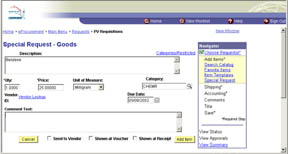 The Lab’s new customized PeopleSoft PRP requisition entry form can be accessed via the web, making the procurement process faster and easier. |
The approval process will no longer involve carrying forms and documentation from one approver’s desk to another. Documentation (specifications, drawings, etc.) in any standard format such as Word, Excel or PDF can be attached to the electronic requisition. Once you enter a requisition into PRP, an automated notification system will send an email to all the required approvers. The e-mail will contain a link to the approver’s PRP web page, who can view the requisition details. Multiple approvers (management, EH&S and budget) can review a requisition simultaneously and approve or deny it online.
Checking the status of a requisition will no longer involve playing phone tag. PRP will provide graphical views of where a requisition is in the approval and procurement cycles. PRP will also automatically send e-mail notifications for important events, such as expiration of subcontracts, voucher payments, damaged material, and order status.
More than a year of planning, design, and testing has gone into the project, which replaces aging and fragmented accounts payable and procurement systems.
“The PRP project has brought together the talents of several Operations departments to provide Berkeley Lab with a state-of-the-art, web-based procurement software system,” said Jeff Weiner, one of the project’s two sponsors. “It will enhance the efficiency of the entire procurement process, both in the divisions and in Financial Services.”
PRP will integrate seamlessly with the Lab’s existing PeopleSoft Financial Management System (FMS), Human Resources (HR), and other systems. They will share the same integrated database, capturing data once at the source, allowing cross-functional reporting and analysis, and allowing users to “drill down” to purchasing and payables financial transaction details. IRIS will continue to be the Lab’s main reporting system, but real-time information will also be available in the PeopleSoft applications. Posting of payments to the General Ledger will be done on a daily instead of weekly basis.
Classes will be offered in June for requisition preparers and buyers to prepare them for using the new application. The classes will demonstrate how PRP handles various Lab business processes, pointing out important features and potential pitfalls. Brown bag lunches will also be held in June to demonstrate PRP’s features and the new online requisition approval process. Employees interested in attending requisition-preparer classes should contact John Speros at JPSperos@lbl.gov. For further information, visit the PRP Web site at http://procurement.lbl.gov/PRP/
By Lisa Gonzales
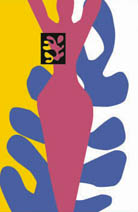 |
As part of its mission to update members of the Lab and surrounding community on the progress in predicting, identifying, and treating breast cancer, Berkeley Lab’s Breast Cancer Research Awareness Forum (BCRAF) resumes on May 28 with two presentations on the relationship between radiation and breast cancer.
Mary Helen Barcellos-Hoff, head of the Cell and Tissue Biology Group in the Life Sciences Division, will discuss how the mammary gland growth is regulated in response to radiation. While many cancer researchers ask how cells become cancerous, Barcellos-Hoff asks: how do tissues become tumors? In this session, she will discuss her latest research about how tissues use extracellular signals to modulate cellular responses to radiation.
“Understanding the basic biology of radiation responses in terms of the cross-talk between extracellular signals and hormones may provide new strategies for treating breast cancer,” says Barcellos-Hoff.
The other speaker will be Catherine Park, M.D., assistant clinical professor in the Department of Radiation Oncology at UC San Francisco. Her talk will focus on the use of therapeutic radiation as a standard treatment for women undergoing breast-preserving surgery for breast cancer.
“In the current clinical setting, the typical course of radiation therapy consists of five to seven weeks of daily treatment, but new and exciting strategies are being developed to improve radiation therapy and decrease the overall treatment time while still maintaining efficacy,” says Park. Her lecture will provide a clinical overview of the use of radiation for breast cancer, reviewing both standard and selected novel approaches.
The BCRAF was begun by former Life Sciences Division Director Mina Bissell to highlight basic research advances in our understanding and control of this disease. The breast cancer research effort at the Lab consists of more than 20 projects amounting to more than $16 million funded by organizations such as the National Institutes of Health, the University of California, the US Army, DOE’s Office of Biological and Environmental Research, and private industry.
The next forum, on June 28, will focus on breast cancer and aging. Judith Campisi of the Life Sciences Division and a professor at the Buck Institute will speak about “Breast Cancer and Aging: What’s the Connection?” Also presenting will be Christopher Benz of the Buck Institute and UCSF.
The BCRAF is held at noon in the Building 50 auditorium. For more information see http://www.lbl.gov/lifesciences/BCancer/index.html.
By Paul Preuss
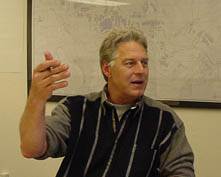 Harry Bash of Facilities |
Carpenter Harry Bash is spending a two-and-a-half-month leave of absence from Berkeley Lab’s Facilities Department to teach an intensive, hands-on program that introduces graduates of the California Conservation Corps (CCC) to the building trades.
“A lot of people become apprentices without knowing much about the trade they’re learning, so if it doesn’t work out, they have to start all over again,” Bash explains. “This pre-apprenticeship program gives an overview of electrical, plumbing, iron work, carpentry, dry wall, and other trades, and should prevent a lot of wasted time.”
Bash says the two dozen students include “eight women, and members of all the minorities,” ranging in age from 18 to 42. “They’re from backgrounds where they’ve been told ‘you can’t do this, you can’t do that.’ Here they are going to get a choice.”
Lou Franchimon, business manager of the Napa-Solano Building Trades Council, organized the pre-apprenticeship program at the request of the CCC, with help from the state’s Employment Development Department. “The CCC grads have all earned their high school diplomas and developed good work habits while in the corps,” he says. “Once they complete this program, we help them with their apprenticeship applications for the trades they’ve chosen.”
Held at the CCC center in the former U.S. Navy shipyard on Mare Island in Vallejo, representatives of individual trade unions do much of the teaching. Harry Bash is teaching a lot of carpentry, but he sees safety as one of the most important concepts he has to convey.
“I’ve been tremendously impressed by the WOW program at Berkeley Lab,” he says, citing the “Workers Observers Workers” safety program coordinated by Bill Birbeck of the Environment, Health & Safety Division. Bash is incorporating WOW concepts in his teaching.
Bash has long been concerned with apprenticeship, and a recent proposal of his has led to a curriculum development program to be funded by the U.S. Department of Labor. Meanwhile, the reward he gets from the CCC program, he says, “is seeing the students’ sense of their own self-worth.”
Last Monday the LBNL Dance Club began a new dance series with the American/International Waltz. Dancers at all skill levels are still welcomed to join the class, as this will be a foundation for future dances. With this series, the club is also transitioning to a new format with two new instructors, Ronnen Levinson and Jessica Parker, the club’s erstwhile practice instructors.
Sessions are held Mondays at noon, with free practices on Thursdays at noon, both in the Building 31 high bay. A review and dance party workshop will be held during the fifth week of the series.
Dances included will be the Viennese Waltz and Bolero, intermediate American and/or International Waltz, and Fox Trot. Future series may include the Hustle, Lindy Hop, Argentine Tango, Quick Step, Balboa, and Collegiate Shag — in addition to the current repertoire of East and West Coast Swing, American Tango, Night Club Two Step, Cha-Cha, Salsa, Rhumba, Merengue, and Samba.
The cost is $6 per session or $20 for a series. For more information contact Joy Kono at jnkono@lbl.gov.
Berkeley Lab’s Latino and Native American Association (LANA) commemorated Cinco de Mayo last Thursday with a special event held on the cafeteria lawn. In addition to the customary celebration and entertainment, this year’s event included the announcement of the first LANA Scholarship Awards.
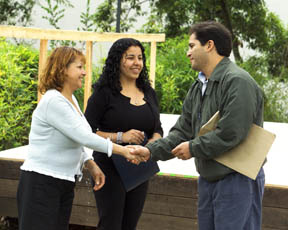 |
The high school award went to Karla Alarcón of Richmond High School (pictured above with her mother and LANA cochair Alex Gavidia of the Engineering Division). The $500 award, in memory of former Lab employee Gabe Ruiz, will assist with some of Alarcón’s higher education costs.
The college award, in memory of late Lab intern Julian Cruz, provides a $500 stipend to encourage Hispanic or Native American students to continue their higher education. The recipient is Blanca Janet Canales of Oxnard. LANA also granted five other $100 awards.
Visitors to the Cinco de Mayo celebration were also treated to a performance of Latin dances by the LBNL Dance Club. Left to right above are dance instructor Jessica Parker, Virgil Alonzo, Jeff Philliber (cochair of LBNL dance club), Anna Smith, Mike Botello, and Anne S. Fleming. Photos by Robert Couto
The Employee Activities Association is sponsoring two sports events this summer: the Oakland A's vs. the Texas Rangers on Sunday, July 21 at 1:05 p.m., and a day at Pacific Bell Park with the SF Giants vs. Montreal Expos on Friday, Aug. 23 at 7:35 p.m. The cost for Lab employees is $7 per ticket for the A’s (instead of the regular price of $16), and $10 for the Giants game.
Tickets are on sale every Wednesday from 12 to 1 p.m. in the cafeteria lobby, on a first come, first served basis. For more information contact Lisa Cordova at X5521.
In order to improve the efficiency of mail and package delivery to Lab employees, Mail Services is implementing the US Postal Service Zip+4 code system, in conjunction with an updated building code system. The new system will result in reduced mail handling, with the following major benefits:
The USPS began using the expanded “Zip+4” system back in 1983, tagging a four-digit add-on to the original five-digit code. This number helps the USPS direct mail more efficiently by identifying a geographic segment within the five-digit delivery area — such as a city block or office building. The system also decreases the potential for human error and the likelihood of misdelivery.
The USPS has designated “+4” numbers from 8000 to 8300 to Berkeley Lab buildings and departments and the UC campus, making it necessary to update the internal building code system.
Under the new codes, “Mail Stop” will be replaced with “Bldg.” in all Lab addresses, and dashes separating the building from the room number (e.g. 69-102) will be replaced with an “R”, as in “69R102”. Mail stops with letters (e.g. 50B-4119) will become” 50B4119.
To make for a smooth transition, employees are asked to use both the updated building codes and +4 zip codes on all return addresses on outgoing USPS mail, business cards, letterheads and other correspondence with a Lab address. Please make sure to also use building codes on all interoffice mail.
The changes will take four to six weeks to be fully implemented and used in directories, but employees are encouraged to start using the Zip+4 at any time.
For a list of Zip+4 codes for the Laboratory, see the Mail Room website at http://http://fac.lbl.gov/Facilities/SiteSvcs/mail.html.
Employer health plans today include a wide variety of health plan choices, such as PPO, POS, HMO plans, or plans like Kaiser-Permanente — an insurance and health maintenance organization all in one. How do you navigate these plans? How will your choice of a plan affect your health and your ability to find the right doctor or have your medication covered?
A brown bag lecture on Thursday, May 30, will address these and other issues. Dr. Christine Brozowski, a family practice physician who recently opened a practice in Berkeley, will discuss the pros and cons of each health plan offered by the University of California, including the physician perspective on insurance plans, and offer suggestions for interviewing and choosing a primary care doctor for your family.
The session will be held from 11:30 a.m. to 1 p.m. in the Building 50 auditorium.
Do you wonder what the vulnerability alerts you receive mean? Could your system be blocked from Internet access because of unpatched vulnerabilities? The next brown bag event on computer protection will address these and other timely issues at noon on Monday, May 20, in Building 2, Room 100B. Jim Mellander of the Computer Protection Program will be the featured speaker. Bring your lunch and your questions.
Space is still available for the Summer 2002 Science Exploration Camp. Children entering second-through-sixth grade may participate in any of the six weekly sessions being held from July 15 through Aug. 23. The camp mixes science and recreation activities centered around weekly themes such as “Puzzles and Puters” and “Earth, Wind and Fire.” The core hours are 9 a.m. to 4 p.m., with free before-and-after care offered from 7:45 a.m. to 5:15 p.m. The registration fee is $200 per week.
Some camp positions are also still open, including counselors-in-training (voluntary positions for teens to gain job experience working with children). Teens may apply to work one or more sessions. For more information, job application requirements, and registration see the Exploration Camp website at http://sciencecamp.lbl.gov/.
COMPUTER SECURITY BROWN BAG
Noon., Bldg. 50 auditorium
SHOEMOBILE
7:30 a.m. – 3:30 p.m., cafeteria parking lot
BREAST CANCER AWARENESS FORUM
Noon, Bldg. 50 auditorium
HEALTH INSURANCE BROWN BAG
11:30 a.m. – 1 p.m., Bldg. 2-100B
Send us your announcements
Announcements for the General Calendar and Bulletin Board page may be sent to MSFriedlander@lbl.gov. Seminar & Lectures items may be mailed to currents_ calendar@ lbl.gov. You may also fax items to X6641 or mail them to Bldg. 65B. The deadline for the May. 31 issue is 5 p.m. Monday, May 27.
CENTER FOR BEAM PHYSICS SEMINAR
Introduction to Quantum Computing
Speaker: Alex Dragt, University of Maryland & LBNL Accelerator and
Fusion Research Division
10:30 a.m., Building 71-264 (Albert Ghiorso Conference Room)
Refreshments served at 10:20 a.m.
LIFE SCIENCES DIVISION SEMINAR
Regulation of Water Movement in Tissues: Mechanisms of Water-Specific
Transport through Water Channels
Speaker: Bing Jap, Life Sciences Division
4:10 p.m., Building 66 auditorium
LIFE SCIENCES DIVISION SEMINAR
Disease Gene Identification Using Population Isolates
Speaker: Leena Peltonen, UCLA & the University of Helsinki, Finland
4:10 p.m. Building 66 auditorium
PHYSICS DIVISION RESEARCH PROGRESS MEETING
Star Wars Means Space Debris
Speaker: Joel Primack, UCSC
4:00 p.m., Building 50 auditorium
PHYSICS DIVISION RESEARCH PROGRESS MEETING
A Study of Inclusive Double-Pomeron-Exchange in CERN
Experiment UA8; Evidence for a Low-Mass Enhancement in the Pomeron-Pomeron
Cross Section
Speaker: Peter Schlein, UCLA
4:00 p.m., Building 50A, Room 5132
Berkeley Lamp developer Michael Siminovitch addresses participants in Berkeley Lab’s “Friends of Science” program about the latest advances in lighting technology, with particular focus on the popular and energy efficient Berkeley Lamp. The session was held the evening of May 6 in Perseverance Hall.
This was the second lecture in a series designed for Friends of Science — a forum for individuals both at the Lab and in the community who share a love for science and wish to further their our understanding of it.
|
Date |
Course |
Time |
Building |
|
|
5/22 |
EHS 283 |
Ultraviolet User Safety |
1:30 – 2:30 |
51–201 |
|
5/22 |
EHS 20 |
EH&S for Supervisors |
2:30 – 4:30 |
51–201 |
|
5/23 |
EHS 400 |
Radiation Protection–Fundamentals |
9:00 – 12:00 |
51–201 |
|
5/23 |
EHS 280 |
Laser Safety |
1:00 – 4:00 |
51–201 |
|
5/28 |
EHS 735/ |
Biosafety/Bloodborne Pathogen |
1:30 – 2:45 |
51–201 |
|
5/29 |
EHS 604 |
Hazardous Waste Generator |
9:30 – 11:00 |
51–201 |
|
5/29 |
EHS 622 |
Radioactive & Mixed Waste |
11:00 – 12:00 |
51–201 |
|
5/30 |
EHS 432 |
Radiation Protection–Lab Safety |
8:00 – 12:30 |
51–201 |
|
5/30 |
EHS 10 |
Introduction to EHS at LBNL |
1:00 – 3:00 |
51–201 |
To enroll, contact Valarie Espinoza at VMEspinoza@lbl.gov or enroll via the web at https://hris.lbl.gov/self_service/training/. Preregistration is required for all courses except EHS 10. For a full, updated schedule, see http://www-ia1.lbl.gov/schedule/.
‘98 TOYOTA CAMRY LE, 17K mi, gold, at, 4 dr, ac, pwr steer/locks, dual airbags, anti-theft device, remote eng start, runs great, exc cond, $15,000 neg, Chang-Su, X4417, 847-2946
‘98 DODGE TRUCK, ext cab, blk/blk, run/looks great, cd, 28K mi, $11,000 bargain, salvage title, Shelley, X6123
‘96 NISSAN SENTRA GXE, 5 spd, teal, 4 dr, 63K mi, am/fm/cass, dual airbags, ac, pwr win/locks, 1 owner, very good cond, well maint, recently serviced, $5,900, Dave, X4024
‘94 JEEP GRAND CHEROKEE, dk red, 4 dr, 6 cyl, at, 108K mi, ac, pwr win, am/ fm/cass, exc cond, orig owner, $8,600, Gary, X4441
‘94 ACURA INTEGRA, 2 dr, 63K mi, at, ac, pwr win/ steer am/fm/cass, airbags, garaged, $7,700/bo, Dave, X4506
‘91 VW JETTA, red, 138K mi, 5 spd, sunrf, runs exc, good gas mi, recent smog check, $2,900/bo, must sell, Gerd, X7052, (925) 335 0114
‘91 TOYOTA COROLLA, 4 dr, 5 spd, ac, 163K mi, white, am/fm/cd, good cond, very economical, $3,800, Reinhold, X5265, 525-3918
‘91 MERCEDES 190E, blk, sunrf, tan int, cd, 4 dr, 124K mi, great shape, $8,900/bo, Shelley, X6123, Holly (925) 945-0524
‘87 HONDA CIVIC DX 2 dr hatch, good cond, at, am/fm, maroon ext, 1 owner, $2,000, Tennessee, 865-2553
‘94 HARLEY DAVIDSON, blk, 44K mi, exc cond, many extras, $10,800 firm, Fred, X4352, 524-4138
ALAMEDA, furn 2 bdrm/1 bth apt, avail 6/29-8/31, no smoking/pets, lge patio, $1,050/mo incl util, Barbara, X6266, 864-0344, barbara_12653@msn.com
ALBANY, large, eleg, furn 2 bdrm/2 bth condo, by week or mo, Geoffrey, 848-1830, gfchew@mindspring.com
BERKELEY B&B near Walnut Square, walk to shuttle, 1 person/rm, 3 rm avail, $650/2 wks, $850/mo, Helen, 527-3252
BERKELEY, charming 2 bdrm/1 bth garden house, w/d, dw, landscaped yard, EBMUD incl, rest of util not incl, $1,850/mo, John or Pauline, 704-9512
BERKELEY, 2 furn rooms avail 1st wk of June in 6 bdrm/2 bth "House of Scholars," info/pics at housintscholar.home.mindspring.com, $670 & $790/ mo incl util, DSL, phone, housecleaning, Anushka, 486-8153
BERKELEY, furn studio 3 mi from BART, 10-15 mi from shuttle, avail 06/01, Shelly/Gordon, 548-9869, shellymandel@attbi. com
EL CERRITO, room close to pub trans, shops, restaurants, housemates UCB grad students, lge house w/ many amenities, w/d, view, dw, hardwd floors, fp, off street parking, $600/mo, Michael, 236-4916
EL SOBRANTE 1 bdrm avail 6/01, sec bdrm avail 7/01 in 3 bdrm/1 bth home, must like pets (owner has dog), shared kitchen, liv rm, w/d, no smoking, quiet, $500/mo+1/3 util, $500 sec dep, Karen, X4384, KSEdwards@lbl.gov
NORTH BERKELEY HILLS newly remodeled studio, sunny, quiet, priv, garden setting, hardwd flrs, kit-chen w/ gas stove, bth w/ bathtub, xtra dressing rm, $925/mo+gas/elec, water & garbage paid, last mo+$600 cleaning dep req, mo-to-mo, pref l/t tenant, 1 pers only, no pets/smoking, Mrs. Wurth, 527-5505
NORTH OAKLAND furn room avail 5/31, 2 bdrm apt w/ shared liv rm, fully equip kitchen, 12 min walk to pub trans, 25 min walk to campus, no smoking/ pets, male pref, roommate is male eng grad student, prorated at $450/mo incl util + $150 dep, David, X7083, dcmays@lbl.gov
SAN LEANDRO 3 bdrm/ 1.5 bth house, quiet neighborhd, close to 580, BART & shops, 1400 sq ft, hardwd flrs, fp, gas stove, dw, w/d, garage, furn opt, pets ok w/ approval & dep, water/garbage pd, avail 8/1 -9/1, $1,700/mo + dep, no smoking, Elizabeth, 352-6429, EAF28bear@aol.com
SAN LEANDRO, big, 3 bdrms for 2 people, priv bth, offstr parking, storage, w&d, dw, fp, patio, plants, lots of rm, walk to shops, recreation, freeways, BART, quiet/safe neighbrhd, 1 person needed, avail 6/1, $850/mo+first/last, 1/2 util, Shelley, X6123, Holden, 614-8535
SOUTH BERKELEY studio apt, 4 unit brown shingle bldg, 15 min walk to campus, near bus, shopping, park, $650/mo incl util, Kathy, X4703, 482-1777, 326-7836
MARRIED PhDs seek furn/ unfurn basement or au pair space to rent, used to 400 sq ft in family student housing, very nice & quiet, must move by 6/30, Jody, X7004, 528-5324
POST BAC FELLOW seeks affordable unfurn room close to Lab, 8/02 – 8/03, clean, quiet, nonsmoking, female violinist w/ 2 cats, parking desired, Papia, pnandi@uiuc.edu.
SHORT-TERM SUBLET for 7/15 – 7/30, Berkeley area, Jerome, X6465, 486-0146
VISITING PROFESSOR & wife from London seeks 1 bdrm apt or housesit near campus for 7/8–8/31, Keith, k.barnham@ic.ac.uk
APPLE PWRBOOK G3/400 Mhz bronze keybrd, 192MB RAM, brand new 6 GB HD installed by Apple (OS 9), cd/dvd, 56K modem, 10/ 100 ethernet, 2 usb, SCSI, 14.1" screen w/ new lid & hinges installed by Apple, new A/C adapter, incl acc: extra batt, charger, media bay zip drive, floppy/super-disk drive (both swap out w/ cd/dvd), $1,300, Charles, (925) 376-3728
HP PAVILION 6470Z, Intel PII 400 MHz, 96 MB RAM, 12.7 GB h.d., 32X cd, 100 MB zip, V.90 56K modem, Win 95, keybrd, new mouse, exc cond, $300/ neg, Dawn, X7307, (925) 252-9212
HUGE MULTIFAMILY yard sale, Sat, 5/18, 8:30-2:00, antique rugs, ethnic arts, collectibles, housewares, books, designer clothing, color TV, cd player, paintings, objects d'arte, furniture, deals galore, Elmwood dist, Russell & Hillegass, Susan, X5437
KIRBY VACUUM less than 6 mos old, all hand attachments/demo shampoo attachment, retails for $2K, selling for $1000, Sheri, X4878, 728-1101
MGA COLOR TV, $50; persian rug, ~ 4’x6’, perf cond, $150; cd player w/out speakers, $10, Susan, X5437
MOVING WARDROBE BOXES, 7, used once, $5/ ea, John, X5523, 614-7696
OAK ENT CENTER, 6’x4’, room for tv, stereo, videos, $100; water filt syst, $100; solid oak din table, 2 leaves, 6' hutch w/ 2 glass drs/sto-rage, server, $1,000; breast pump, $100, must sell, Shelley, X6123, Holly, (925) 945-0524
SF OPERA TICKETS, balc pr, 2nd row ctr, Carmen 6/8, Butterfly 6/15, Giulio Cesare 6/29, $120/pr, Paul, X5508
SLEEPER SOFA, light tan, oak trim, folds out to queen size bed, $150/bo, Deb, X7078
WATERBED, queen size, wool cover, $150; drop table, $40; 2 bikes, $35/ea, John, X5193, (925) 284-7447
YAMAHA console piano ca. 1967, walnut cabinet, good cond, $2,000/bo; Panasonic 17" color TV, $125, Nan, 524-5185
KIDS FOR COOKING CLASS, looking for a couple of 11-16 yr olds to join our 13-yr-old son in a priv Thai/Indian veg cooking class this summer, Mike, X4669, 843-1598
SOUTH LAKE TAHOE, spacious chalet close to Heavenly, fully furn, sleeps 8+, pool/spa in clubhouse, close to attractions, $150/ day+$75 clean fee, Angela, X7712, Pat/Maria, 724-9450
TAHOE KEYS at S. Lake Tahoe, 3 bdrm/2.5 bth house, close to attractions, great views, $195/night, Bob, (925) 376-2211
GERMANIUM WAFER found, label on case reads "Charlie," Maurice, X7354
Ads are accepted only from LBNL employees, retirees, and onsite DOE personnel. Only items of your own personal property may be offered for sale.
Submissions must include name, affiliation, extension, and home phone. Ads must be submitted in writing via e-mail (fleamarket@lbl.gov) or fax (X6641). Ads run one time only unless resubmitted, and are repeated only as space permits. They may not be retracted.
The deadline for the May 31, 2002 issue is Thursday, May 23.